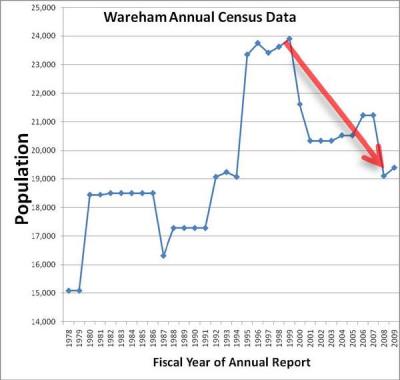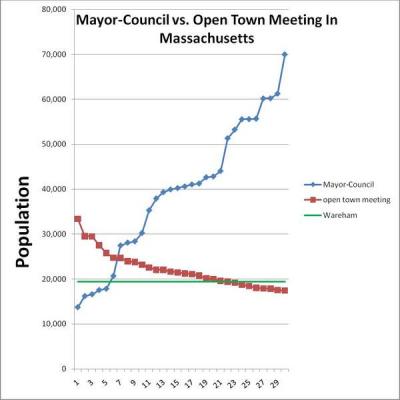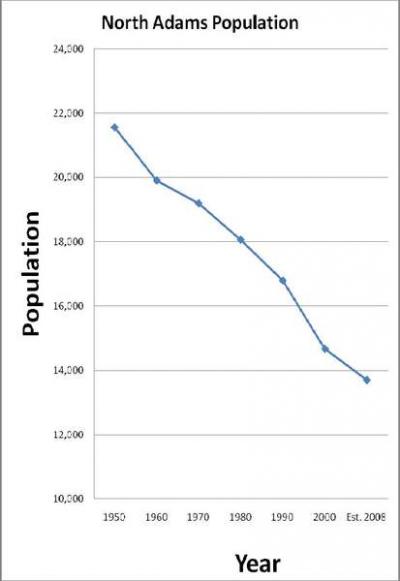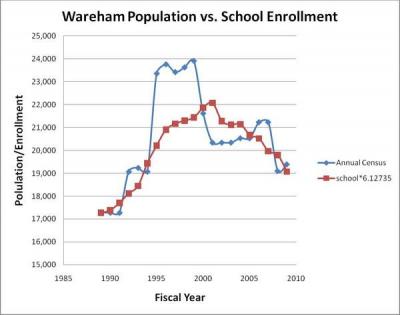Charter Review Committee Makes False Population Claims
Here is the short version of this article.
The Charter Review Committee will propose a new charter for Wareham at the next Town Meeting. This proposed charter takes away from the Wareham open town meeting voter two things. It takes away the power to enact legislation and the power to control tax dollars. In its support of this plan, the Charter Review Committee has misled the public by using false census data. In order to suggest that Wareham is getting too large for the Open Town Meeting form of government, they have falsely stated that Wareham has 22,000 residents and is growing. In fact, since the 2000 census, when Wareham had a population of 20,335, the number of residents has been decreasing. The latest, processed annual town census figure is 19,386 (January 2009).
The Town Clerk is responsible for the annual town census and the town report, which contains population figures. Both the FY2009 Town Report and a Charter Review Committee document reports a (winter) population of 22,000. When asked to justify the 22,000 figure, the Clerk’s Office said the value was rounded. Such an explanation is unsatisfactory, because 19,386 rounds to 19,000, not 22,000. Note that the Town Clerk is a member of the current Charter Review Committee.
Information that relates town size to form of government, as well as additional confirmation of Wareham’s population decrease over the past decade, can be found in the long version of this article.
In conclusion, there might be good reasons for Wareham to change from an Open Town Meeting form of government to a Mayoral-Council form. Growth in the town’s population is not one of them – Wareham’s population has declined over the past decade.
Here is the long version of this article.
One thing we have been hearing continuously from the Charter Review Committee is that Wareham is growing too large for the open town meeting form of government.
We have heard it from Charter Review Committee Chairman Alan Slavini :
“The town’s getting bigger. The town’s newest census will probably come out somewhere closer to 25,000 than 20,000.”
We have heard it from Charter Review Committee Vice-Chairman Michael L. Jonesii:
“…this town is too big for the current form of government. “
and we have seen it in a Charter Review Committee documentiii:
'Wareham's government is based on a form of self governance that was appropriate in the mid 1700s when our town was extremely small, but today in Wareham we are 22,000 strong, and growing**.
** "Studies of New England town meetings have shown that such gatherings cease to be effective for large populations. They may work in communities of a few hundred, but when the population reaches the many thousands, attendance drops and the connection to citizens atrophies." Prof. Jas. Fishkin'
At least superficially, this argument is compelling. I can imagine Wareham with a population “22,000 strong” and growing so large that the open town meeting becomes impractical. I can imagine Wareham foolishly trying to continue with open town meetings when all other towns its size have long since changed to a more practical form of government. However, my personal experience with town meeting over the past few years didn’t suggest any size problem. The number of attendees generally fit comfortably in the high school auditorium, and there was hardly ever a need for overflow into the cafeteria.
The statements of the Charter Review Committee raise a number of questions, and it will be helpful to list them explicitly:
1. Is the population of Wareham 22,000?
2. Is the population of Wareham growing?
3. How many towns in Massachusetts have an open town meeting form of government?
4. How many municipalities in Massachusetts have a mayor/council form of government (the form being proposed by the Charter Review Committee)?
5.How many towns larger than Wareham have open town meetings?
6.How many cities with a mayor/council form of government are smaller than Wareham?
Before I answer these questions, I want to comment on the footnote that was placed in the Charter Review Committee document. This footnote is a classic example of how inappropriate rhetoric can be used to falsely suggest to the reader things that are simply not true. Note first that the statement is attributed to “Prof. Jas. Fishkin.” This statement does two things. First, the attribution makes an appeal to authority: the author is identified as a professor. Second, although the first and last name is given, the form makes it difficult to track down the source. The author’s name is actually James Fishkin. Notice that the “Studies of New England town meetings” are not identified so the context of the statement cannot be determined. In particular, there are many town meeting forms, six states in New England, many different kinds of towns, and towns have changed significantly over the past hundred years or so. The statement is also a distraction, because even if the study’s results were found to be an accurate assessment, the real task at hand is to determine a satisfactory alternative. What we do know, if one reads the article, is that James Fishkin is not recommending a mayoral/council form of government as an alternative. He is calling for what he calls “deliberative polls” which look nothing like the form of government that the Charter Review Committee is recommendingiv.
Let me return to the issues relating to population. If we go to Wareham’s Annual Reports over the past 32 years, we can answer the questions about Wareham’s current population and whether or not the town is growing. I should say that the population figures reported in the annual Reports are not necessarily accurate. In fact, in some years I believe the value was simply copied from the previous year. I will address this issue in more detail later in the article.
We can see from the graph below that Wareham’s population generally increased between 1978 and 1999 when it peaked at 23,899. Since that time, the population has decreased overall and, since the year 2000, has never been 22,000, even rounding to the nearest 1000. In fact, the official 2000 census figure is 20,335 and the last annual census (January 2009) puts the figure at 19,386. Obviously 19,386 does not round to 22,000, so there is no justification for using this value in Wareham’s Annual Report or Charter Review Committee documents.

We have now answered the first two questions: Wareham’s population is about 19,386 and has trended downward over the past decade. Let’s consider the questions regarding the towns which have either open town meetings or the mayoral/council form of government. It is easy to find a list onlinev of all 351 municipalities in Massachusetts along with their form of government. From this list we can easily determine that 259 use an open town meeting form of government and 36 use the mayor-council form being proposed by the Charter Review Committee. To put it another way, in Massachusetts, the most popular form of local government is the open town meeting and it is used by more than 73 percent of all municipalities. The mayor-council form is, of course, used for all the major cities like Boston, Springfield, Brockton, Quincy, and New Bedford. The populations in these cities range from approximately 91,000 to 609,000.
You can take the online population data and sort the 30 most populous open town meeting municipalities from the most populous to the least populous and sort the 30 least populous mayoral-council cities from least populous to most populous. When this sorted data is graphed, as I have done below, you may discover something surprising.

The graph shows that even though the Mayoral-council form is usually for big cities, it is sometimes used in municipalities with a population less than some towns that use the open town meeting form. The green line represents a population of 19,386, which is the latest census figure we have for Wareham. There are 22 towns larger than Wareham that still use the Open Town Meeting form of government1 . Dracut and Tewksbury are two such towns with populations over 29,000. Andover has over 33,000.
Only 5 towns smaller than Wareham use the Mayoral-Council form. You might wonder why a town like North Adams, with only 13,711 residents uses the Mayoral-Council form. The following graph suggests a possible reason.

The decrease in population is quite dramatic. By law, towns of less than 12,000 may not have a city form of government, so North Adams may have to change its form of government if this trend continuesvi.
We now know that the FY2000 town report incorrectly states Wareham’s current population. There is evidence that other town report census figures are incorrect. For example, in 4 different time spans (1989-1991, 2001-2003, 2004-2005, and 2006-2007) the population figures are given as constant. Statistically, a perfectly constant population size is highly unlikely. This raises the suspicion that the figures were copied from the previous year rather than derived from actual census data. Because the Town Report’s are suspect, one would like to find other corroborating evidence that Wareham’s population has decreased during the past decade. One might discover such evidence after considering the effect of a decreasing population. For example, when the population decreases, school enrollment also usually decreases. In fact, the school system keeps very accurate records of enrollment and must report this figure to the state each year. The state’s snapshot of enrollment is taken October 1st each year. By scaling the actual enrollment figure by a factor slightly greater than 6, we can compare Wareham’s annual census data to the school’s enrollment figures on the same graph. This is done below.

From the graph you can see that since fiscal year 2000, both the annual census and school enrollment have shown a downward trend.
In conclusion, there might be good reasons for Wareham to change from an Open Town Meeting form of government to a Mayoral-Council form. Growth in the town’s population is not one of them – Wareham’s population has declined over the past decade.
References
i WCTV Daily Gumbo November 9, 2009 online at http://takebackwareham86bos.blogspot.com/2009/11/wctv-daily-gumbocrc-11909.html Approximately 20:37 into Part 1.
ii E-mail exchange between Michael L. Jones and Larry McDonald dated January 16, 2010 8:09 pm
iv The article is an August 15, 2009, New York Times Op-ed that can be found online at http://www.nytimes.com/2009/08/16/opinion/16fishkin.html?_r=1 .
v http://en.wikipedia.org/wiki/List_of_municipalities_in_Massachusetts#List_of_municipalities
vi http://www.massmanagers.org/Pages/MMMA_Resources/government
Footnotes
1 Care must be taken when stating this kind of statistic. The census data for all the cities is from the U.S. 2000 census, and the green line represents Wareham’s population for Fiscal Year 2009. This is a useful comparison in this instance because the intent is to judge when municipality size is inappropriate for Open Town Meeting. However, since the data source years are different, the number of cities greater than Wareham in Fiscal Year 2009 is only an estimate. A completely accurate count of these municipalities can be determined when the U.S. 2010 Census figures are available.
















